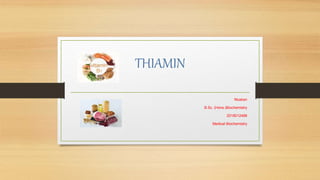
Muskan
- 2. INTRODUCTION • Thiamin (or thiamine) is one of the water-soluble B vitamins. • Also known as Vitamin B1 • Natural present in some foods • Available as a dietary supplement • Plays a critical role in energy metabolism and, in the growth, development, and function of cells.
- 4. DEFICIENCY SYMPTOMS • Leads to beriberi (a condition that features problems with the peripheral nerves and wasting). • Weight loss • Anorexia • Mental problem including confusion and short term memory loss • Muscle weakening • Cardiovascular symptoms occurs ( for e.g. enlarged heart)
- 5. FUNCTION • All vitamin B are water soluble, they help to convert carbohydrates, fats, and protein into energy, or glucose. • Necessary for keeping the liver, skin, hair, and eyes healthy. • They also play a role in the nervous system, and they are needed for good brain function. • B vitamins are sometimes called anti-stress vitamins, because they boost the body’s immune system in times of stress.
- 7. METABOLISM
- 8. ABSORPTIONOF THIAMIN • Thiamine released by the action of phosphatase and pyrophosphatase in the upper small intestine is absorbed in two ways. 1. At lower conc.(<2 micro meter) the process is carrier- mediated 2. At higher conc. (2.5 mg dose) passive diffusion also occurs. • The active transport mechanism is greatest in the proximal regions of the small intestine. • The cells of the intestinal mucosa have a thiamine pyrophosphokinase activity, with a Km about the same as that of the carrier-mediated absorption process.
- 9. TRANSPORT OF THIAMIN • Thiamin is taken up the cells of the blood and other tissues by active transport. • Intracellular thiamine occurs predominately (80%) in phosphorylated form, most of which is bound to proteins. • Its uptake and secretion is mediated mostly by a soluble thiamine transporter that is dependent on Na+ and transcellular proton gradient. • The transporter has been cloned and mapped to the human chromosome. • The greatest amounts of the transporter have been found in skeletal muscle, heart and placenta. • Low or non detectable amounts of transporter have been found in liver ,kidney ,brain and intestine
- 10. REFERNCE VALUES
- 11. Source of Content • Krause’s Food and nutrition care process Book • PubMed • Natinal Institue of Health – Fact sheet